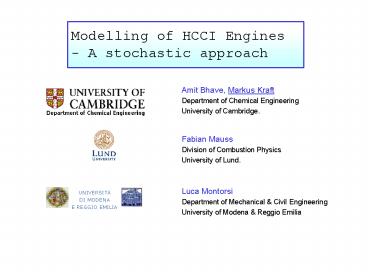Stochastic Modelling of HCCI Engines - PowerPoint PPT Presentation
1 / 32
Title:
Stochastic Modelling of HCCI Engines
Description:
Two stroke gasoline engine [Onishi et al. 1979, Noguchi et al. 1979] ... Single cylinder Volvo TD 100-series diesel engine, converted for HCCI ... – PowerPoint PPT presentation
Number of Views:189
Avg rating:3.0/5.0
Title: Stochastic Modelling of HCCI Engines
1
Modelling of HCCI Engines - A stochastic approach
Amit Bhave, Markus Kraft Department of Chemical
Engineering University of Cambridge.
Fabian Mauss Division of Combustion
Physics University of Lund.
Luca Montorsi Department of Mechanical Civil
Engineering University of Modena Reggio Emilia
UNIVERSITÁ DI MODENA E REGGIO EMILIA
2
Outline
- Introduction
- Motivation
- Stochastic Reactor Model
- Stochastic Heat Transfer model
- GT-Power (1-D CFD code)
- Engine Case study 1
- Engine Case study 2
- Conclusions
- Future work
Animation edited by G. Leung, Original from
Mitsubushi Corp.
3
HCCI/CAI
- HCCI Homogeneous Charge compression Ignition
- CAI Controlled Auto-Ignition
- Hybrid of SI and CIDI
- Background literature
- - Two stroke gasoline engine Onishi et al.
1979, Noguchi et al. 1979 - - Four stroke engines Najt and Foster 1983
4
HCCI Combustion
(2) The charge is compressed
(1)Intake of a premixed charge
(3) The charge is compressed further
(4) Infinitesimaly later
Figures originally from Lund Institute of
Technology
5
HCCI A Future Engine Strategy
Challenges
Merits
- Difficulty in starting and control of engine
- High CO and HC emissions
- High loads
- High thermal efficiency
- Low NOx emissions
- Low PM emissions
6
Modelling development
- Single zone model (closed volume) Smith, R. et.
al 1997 - PDF model (closed volume) Kraft, M., Mauss, F.,
et. al. 1998 - Multi-zone model (closed volume) Aceves, S.M.,
Agarwal, A. et. al. 2000 - Single/Multi-zone model CFD (full engine cycle)
Fiveland, S. B., Aceves. S. M., et. al. 2001
7
Motivation
- We present PDF based model 1-D CFD based
engine simulation tool - Full cycle simulation
- Internal EGR
- Gas dynamics
- PDF model (Stochastic Reactor Model)
- Local inhomogeneities due to scalars
temperature, density, composition - Detail chemical kinetics (no reaction closure
problems) - Mixing and fluctuations
8
Stochastic Reactor Model (SRM)
- Local Quantities Temperature and mass fractions
- Joint scalar Mass Density Function (MDF),
- Partially Stirred Plug Flow Reactor (PaSPFR)
- Solution Monte Carlo (stochastic) Particle Method
9
PaSPFR model parameters
Velocity Fluctuations Integral Length
Scale Turbulent Mixing Time Energy Dissipation
10
Source Terms
- Effect of chemical kinetics
- Effect of change in volume, heat losses, and
reactions
11
Global Quantities
- Instantaneous Volume
- Mean density
- In-cylinder pressure
12
Monte Carlo Method
Given a state FN at time t0
- Monte Carlo particle method with second order
time splitting - ?t the global deterministic time step
- Mixing is carried out over ?t/2
Time marching t0?t
Stochastic heat transfer
Mixing
Reaction, heat loss, dV
Mixing
13
PDF equation transformation
14
Stochastic Heat Transfer Model(SHTM)
- ODE representing the heat transfer by convection
- The analytical solution of the heat transfer ODE
is
- Stochastic particle system of the form T(n)
(t) n 1, , N - - Account for fluctuation
- - Particle-wall interaction
15
Validation of SHTM
- Heat transfer by convection for an ith stochastic
particle,where, hg is the Woschni heat transfer
coefficient - The generator of the stochastic process is given
by
Chemical kinetics not included
16
Algorithm
- Given the state of the system, at
time, - Calculate the fluctuation for the particles
- Wait an exponentially distributed time step with
parameter - Choose particle index according to uniform
distribution 1,N - Perform temperature jumps
- If go to step 2.
- Parameters used for the study N 125, Ch 50
17
Introducing fluctuations
Finite difference scheme
18
Sensitivity w.r.t. N
Simulations Pentium III, 866 MHz CPU time N
100, 55 min. N 800, 8 h
19
I-D CFD Code GT-Power
20
Tasks GT-Power PDF Model
1-D fluid-dynamics code
Detailed kinetic code
GT-Power
PDF Model
- Processes occurring in the inlet and exhaust
layouts - Injection system
- Turbocharger
- Waste-gate valve
- Intercooler
- EGR system
- Duty cycles
- Control strategies
- Chemical reactions occurring during combustion
- Ignition delay
- Combustion heat release
- Engine emissions
21
I-D CFD code PDF Model interface
GT-Power
At every GT-Power time step
22
Test Case-1
- Experimental data Prof. Bengt Johansson,LTH
Lund, Sweden - Single cylinder Volvo TD 100-series diesel
engine, converted for HCCI - Only Stochastic reactor model used (no CFD
linking)
23
Engine specifications
- Fuel Natural gas
- Application stationary engine market
- Exhaust Gas recirculation (EGR)
- - Fundamental control parameter
EGR specifications
24
Model validation
In-cylinder pressure
- 0 EGR
- Pressure agreement
- Ignition time Crank Angle Degree (CAD) agreement
25
Effect of EGR
38 EGR
47 EGR
- With EGR
- reduction in peak pressure,
- Ignition time delays
- No charge heating effect EGR cooled and recycled
26
CO emissions
27
HC emissions
28
Test case - 2
- 12 liter in line 6 cylinder direct injection
turbocharged SCANIA serial manufactured diesel
engine - Luca Montorsi, University of Modena and Reggio
Emilia
29
SRM model validation test bed
Incylinder pressure profile
30
SRM GT-Power
In-cylinder pressure
31
Conclusions
- Stochastic Heat Transfer Model
- Accounts for fluctuations
- Models fluid-wall interaction effects
- Stochastic Reactor Model
- Accounts for inhomogeneities
- Reduction in peak pressure and delay in
auto-ignition with EGR - Predicts the effect of EGR on emissions
- The conjunction of stochastic reactor model with
the 1-D CFD code enabled full cycle simulation.
32
Acknowledgements
- Cambridge Commonwealth Trust and ORS Committee
- Fabian Mauss Division of Combustion Physics,
Lund University, Sweden - Luca Montorsi University of Modena, Italy
- EPSRC
- Marie Curie - EU Trainings Site































